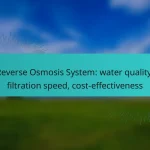Ceramic filters are vital for ensuring clean water, and maintaining their performance requires regular attention. Cleaning should be done every 4 to 6 weeks to prevent clogging, while routine inspections for cracks are essential to avoid contamination. Additionally, timely replacement of filters showing signs of wear will help sustain water quality and filtration efficiency.

How often should you clean a ceramic filter in London?
In London, ceramic filters should typically be cleaned every 4 to 6 weeks to maintain optimal performance. Regular cleaning helps prevent clogging and ensures that the filter continues to provide clean water.
Every 4 to 6 weeks
Cleaning your ceramic filter every 4 to 6 weeks is a good practice to ensure it functions effectively. This timeframe allows for the removal of accumulated contaminants without risking a significant drop in filtration efficiency.
During this cleaning, you can gently scrub the filter surface with a soft brush and rinse it with clean water. Avoid using harsh chemicals, as they can damage the ceramic material.
After heavy usage
If your ceramic filter has been used heavily, it’s advisable to clean it immediately afterward. Heavy usage may include periods of high demand, such as hosting guests or during hot weather when water consumption increases.
After such periods, inspect the filter for any visible buildup or discoloration, and perform a thorough cleaning to restore its effectiveness.
Seasonal cleaning recommendations
Seasonal cleaning is also beneficial, especially before and after winter. In London, the colder months can lead to increased sediment in water sources, making it essential to check and clean your filter more frequently during this time.
Additionally, at the start of spring, consider a deep clean to remove any accumulated contaminants from the winter months, ensuring your filter is ready for the warmer season ahead.
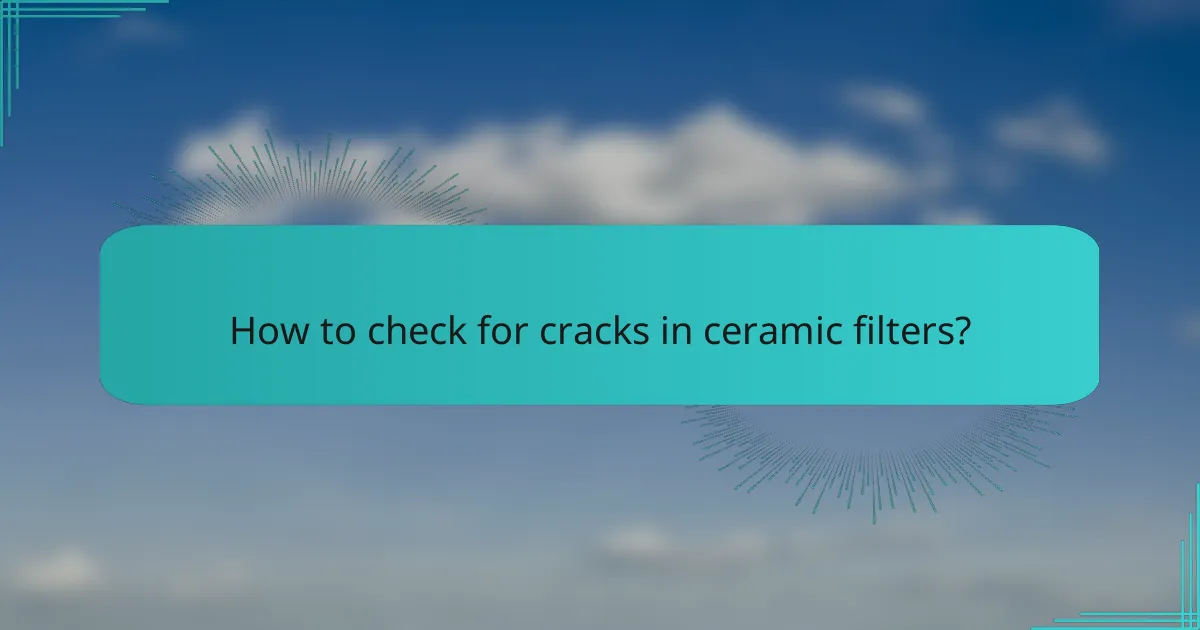
How to check for cracks in ceramic filters?
Checking for cracks in ceramic filters is essential to ensure their effectiveness and longevity. Regular inspections can prevent water contamination and maintain filtration efficiency.
Visual inspection for surface damage
A visual inspection is the first step in checking for cracks in ceramic filters. Look for any visible surface damage such as chips, fractures, or discoloration that may indicate structural weaknesses. Pay special attention to areas that experience high stress or frequent handling.
Use a bright light to illuminate the filter and inspect it from different angles. If you notice any irregularities, mark them for further evaluation or replacement.
Water leakage tests
Conducting water leakage tests can help identify cracks that are not visible during a standard inspection. Submerge the filter in water and observe for any air bubbles escaping, which indicates a crack. This method is particularly effective for detecting small, hairline fractures.
Alternatively, you can fill the filter with water and let it sit for a few hours. If the water level drops significantly, it may suggest a leak due to a crack. Always ensure to perform these tests in a controlled environment to avoid contamination.

What are the replacement tips for ceramic filters?
To ensure optimal performance, ceramic filters should be replaced when they show signs of wear or damage. Regular checks for cracks and other indicators can help maintain water quality and filter efficiency.
Signs that indicate replacement
Look for visible cracks or chips in the ceramic material, as these can compromise filtration effectiveness. Additionally, if you notice a significant decrease in water flow or an unusual taste or odor in the filtered water, it may be time to replace the filter.
Another sign is the buildup of contaminants on the filter surface. If cleaning does not restore normal flow rates, replacement is necessary to ensure safe drinking water.
Best practices for replacing filters
When replacing ceramic filters, always follow the manufacturer’s guidelines for specific models. Start by turning off the water supply and carefully removing the old filter to avoid spills.
Before installing the new filter, clean the housing to prevent contamination. Ensure a tight seal to avoid leaks, and run water through the new filter for a few minutes before use to flush out any residual particles.
Keep a replacement schedule based on usage and water quality, typically every 6 to 12 months, to maintain optimal performance. Regular checks can help you stay ahead of any issues and ensure clean water supply.
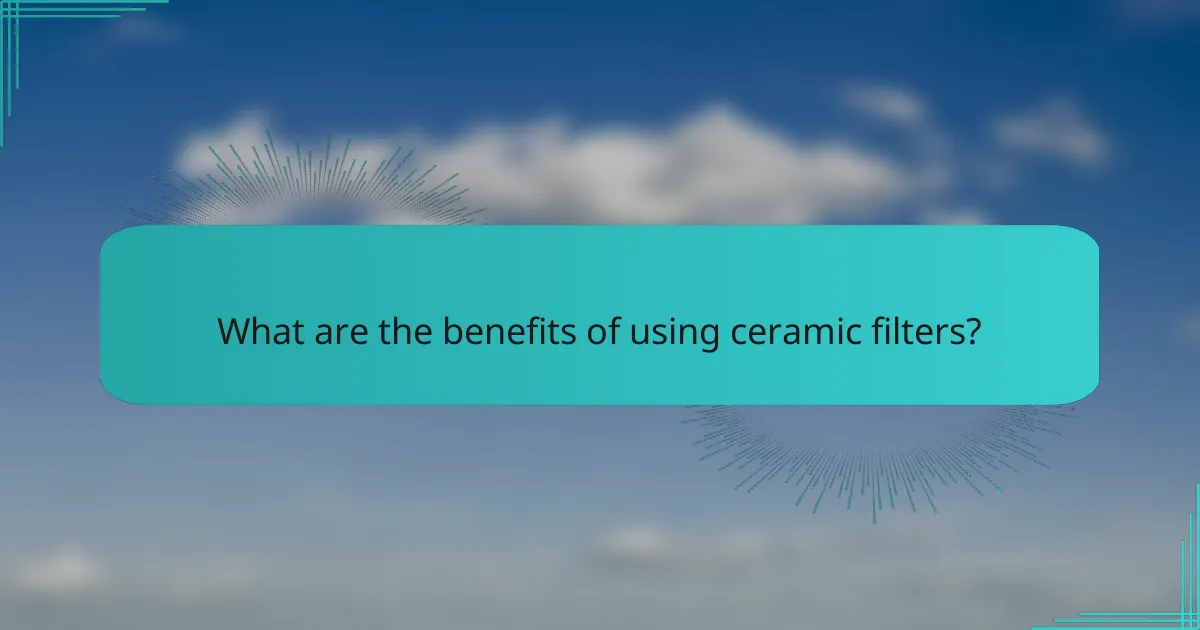
What are the benefits of using ceramic filters?
Ceramic filters offer effective filtration of water by removing contaminants while being durable and long-lasting. Their unique structure allows for efficient purification, making them a popular choice for both household and industrial applications.
Effective removal of contaminants
Ceramic filters are designed to trap a wide range of contaminants, including bacteria, sediment, and larger particles. Their porous structure allows water to flow through while blocking harmful substances, ensuring cleaner drinking water.
Regular maintenance, such as cleaning the filter, enhances its effectiveness. It is advisable to check the filter’s performance periodically and replace it if the flow rate decreases significantly, indicating clogging or saturation.
Long lifespan and durability
One of the key advantages of ceramic filters is their long lifespan, often exceeding several years with proper care. Unlike other types of filters, ceramic filters can be cleaned and reused multiple times, making them a cost-effective solution.
To maximize durability, avoid exposing the filter to extreme temperatures or physical damage. Regularly inspect for cracks or chips, as these can compromise the filter’s integrity and effectiveness. If any damage is found, it is best to replace the filter promptly to ensure continued water quality.
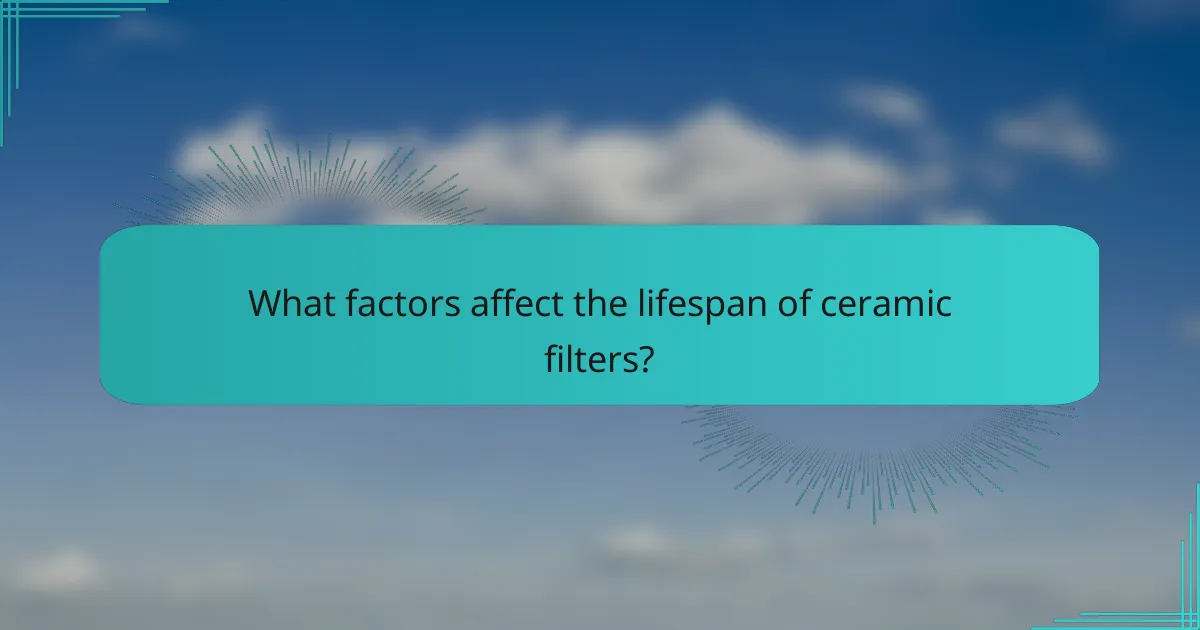
What factors affect the lifespan of ceramic filters?
The lifespan of ceramic filters is influenced by water quality, usage frequency, and maintenance practices. Understanding these factors can help ensure optimal performance and longevity of the filters.
Water quality and usage frequency
Water quality plays a significant role in the lifespan of ceramic filters. High levels of contaminants, such as sediment and chlorine, can lead to faster clogging and degradation of the filter material. Regular testing of water quality can help identify any issues that may shorten the filter’s lifespan.
Usage frequency also impacts how quickly a ceramic filter wears out. Filters used in high-demand situations, such as in households with large families or in areas with frequent water shortages, may need more frequent cleaning and replacement compared to those used less often. Establishing a routine based on usage can help manage filter longevity.
Maintenance practices
Proper maintenance is essential for extending the life of ceramic filters. Regular cleaning, typically every few weeks, can prevent buildup and ensure efficient filtration. Use a soft brush or cloth to gently clean the surface without damaging the ceramic material.
Additionally, checking for cracks or damage is crucial. Inspect the filter periodically for any visible signs of wear. If cracks are found, it’s advisable to replace the filter immediately to avoid contamination. Keeping a maintenance log can help track cleaning schedules and inspections, ensuring timely actions are taken.
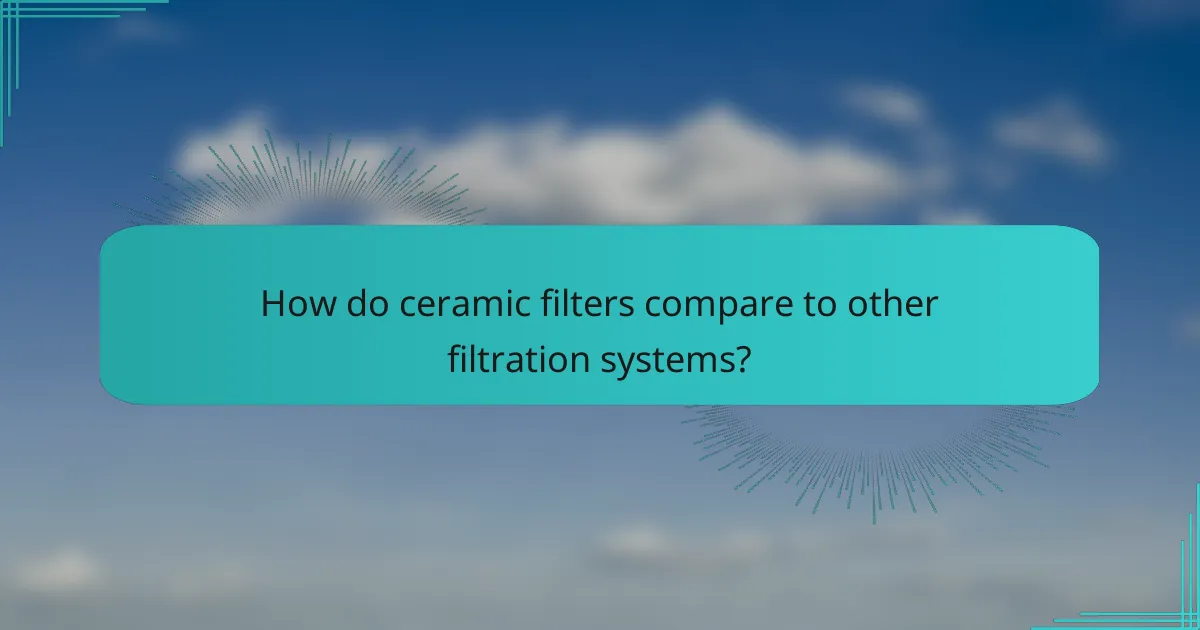
How do ceramic filters compare to other filtration systems?
Ceramic filters are often favored for their durability and effectiveness compared to other filtration systems. They provide a reliable method for removing contaminants from water while being cost-effective and easy to maintain.
Cost-effectiveness
Ceramic filters typically have a lower initial cost than many advanced filtration systems, such as reverse osmosis units. Their longevity can also lead to savings over time, as they often last several years with proper maintenance.
When considering cost-effectiveness, factor in the price of replacement filters and maintenance. While ceramic filters may require occasional cleaning, they do not need frequent replacements, which can be a significant advantage over other systems that may have higher ongoing costs.
Filtration efficiency
Ceramic filters are known for their high filtration efficiency, effectively removing bacteria, protozoa, and sediment from water. They can filter down to a few microns, making them suitable for various water sources.
However, they may not remove all chemical contaminants or viruses as effectively as some other systems, such as activated carbon filters or UV purifiers. It’s essential to assess your specific water quality needs and consider combining filtration methods for optimal results.

What are the common issues with ceramic filters?
Ceramic filters can face several common issues, including clogging, cracks, and the need for replacement. Regular maintenance and inspection are crucial to ensure optimal performance and longevity.
Cleaning frequency
Cleaning ceramic filters is essential to maintain their efficiency. Generally, it is recommended to clean them every few weeks, but this can vary based on usage and water quality. If you notice a decrease in flow rate, it’s a clear sign that cleaning is needed.
To clean a ceramic filter, gently scrub the surface with a soft brush or cloth and rinse it with clean water. Avoid using harsh chemicals, as they can damage the ceramic material.
Checking for cracks
Regularly checking for cracks in ceramic filters is vital, as even small fractures can lead to reduced filtration efficiency. Inspect the filter visually for any visible damage, especially after cleaning or heavy use.
If you find cracks, it is advisable to replace the filter immediately. Continuing to use a cracked filter can compromise water quality and safety.
Replacement tips
Replacing ceramic filters typically depends on usage and condition, but a good rule of thumb is to consider replacement every 6 to 12 months. Factors such as water quality and the amount of sediment can affect this timeline.
When replacing, ensure you choose a filter that matches your system’s specifications. Follow the manufacturer’s guidelines for installation to avoid issues during operation.

